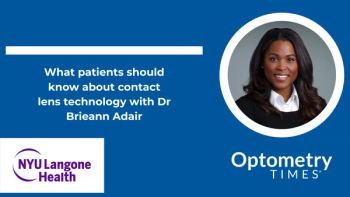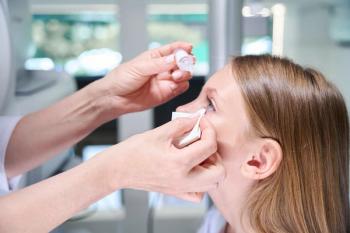
- April digital edition 2022
- Volume 14
- Issue 4
Contact lens disinfection methods still matter
Long-term success of contact lens wearers attributed to education, professional input on cleaning methods
Common sense would suggest that not cleaning contact lenses correctly can lead to eye infection and inflammation.
Nevertheless, 99% of lens wearers admit to engaging in at least 1 risky behavior when it comes to lens hygiene.1
Thus, eye care providers must recommend the right lens disinfectant to their patients and impress upon them the need to follow to the letter the instructions on the packaging.
Multipurpose solutions
About 60% of patients still wear reusable lenses,2 and all-in-one systems appeal to them because of their convenience.
However, ensuring that these systems don’t cause infections or inflammation requires that the lenses be rubbed and rinsed3 for > 10 seconds every time they are removed and that the solution is never “topped off”; instead, fresh solution should be added to the case before the lenses are stored.
Although many effective multipurpose solutions exist,4 comparing generic and brand-name products can be difficult for eye care providers and consumers alike because they contain different preservatives and surfactants and their mechanisms of action differ. Research leading to the approval of disinfecting agents for use in humans adheres strictly to the instructions on the packaging, and real-world safety depends on the same adherence. Unfortunately, most patients who use multipurpose solutions say that they don’t follow the aforementioned instructions.
Thus, the ease of use of multipurpose solutions might more properly be termed misuse that compromises their effectiveness.
Determining efficacy
Different types of bacteria can also alter the performance of a disinfectant. For example, Pseudomonas aeruginosa adheres to the lens surface more than Staphylococcus aureus.4 Gram-negative organisms have a stronger resistance to microbicides than gram-positive organisms.4 Different surface coatings on lenses can also affect their interaction with, and the overall performance of, the disinfecting solution.
Most cleaning solutions contain similar base ingredients. Phosphate-buffered saline is prepared with mild antibacterial biocides such as polyaminopropyl biguanide, polyquaternium, polyhexamethylene biguanide, polyhexanide hydrochloride, polyquaternium-1, and myristamidopropyl dimethylamine.5 These biocides kill bacteria or disrupt bacterial adhesion to the surface of the lens.6
To reduce surface tension and increase surface moisture, each brand has a proprietary wetting agent that conditions the lens. Finally, multipurpose solutions contain preservatives like boric acid, sodium borate, and sodium chloride, that keep them sterile, but some patients may be sensitive to such preservatives or to the concentrations used. For them, other disinfecting methods are recommended.
Hydrogen peroxide solutions
These solutions are not used in the United States as frequently as multipurpose ones because they are recommended by only about 25% of US eye care professionals.
However, because they are reported to have fewer complications,7–9 they can be recommended for patients who wear soft lenses, corneal gas permeable lenses, hybrid lenses, and scleral lenses, and for those who are sensitive to the preservatives in multipurpose solutions, have ocular allergies or dryness, or experience nonspecific lens discomfort. A 2018 report found that peroxide solutions were superior to multipurpose ones in terms of compliance, ease of use, efficacy of disinfection, comfort, and ocular surface safety.9
Originally introduced in the early 1970s, these systems dominated the market until the development of multipurpose systems.8,10 There are 2 types of hydrogen peroxide (H2O2) products: a 2-step system that requires lenses be soaked in a 3% H2O2 solution overnight and then introducing a neutralizing agent 8,11 and the more common 1-step system that uses either a platinum disk or a time-release catalase tablet to neutralize the peroxide.
Today’s H2O2 products include surfactants that aid in deposit removal and lens wettability,9 and they don’t have preservatives, which may also improve their overall comfort when compared to multipurpose solutions.8,12
H2O2 solutions are biocides that destroy bacteria, fungi, and protozoa9 by producing free radicals that act as oxidizing agents, damaging microorganismal cell membranes and penetrating biofilms.10
Before the lenses can be put on, H2O2 solutions must be turned to water and oxygen by a neutralizer.13 Peroxidases are enzymes on the ocular surface that, with normal blinking, can metabolize H2O2 within 60 seconds and avoid damage to the membranes of ocular surface cells.13,14
Some eye care providers may hesitate to recommend H2O2 systems because of concerns about lens care noncompliance.
However, a 2007 study reported that 37% of multipurpose solution users self-reported compliance, whereas fully 100% of H2O2 users reported compliance when using the 1-step system.15
Conclusion
Ultimately, patient education is the key to compliance. Patients must be taught never to rinse lenses with the H2O2 solution, never to use topical hydrogen peroxide sold in brown bottles on lenses, and always to leave lenses in the H2O2 solution for the amount of time recommended for full neutralization. Comfortable, long-term, adverse effect–free contact lens wear depends on patient compliance with their eye care practitioner’s recommendations and with the instructions on the disinfectant’s packaging.
References
1. Cope JR, Collier SA, Rao MM, et al. Contact lens wearer demographics and risk behaviors for contact lens-related eye infections—United States, 2014. MMWR Morb Mortal Wkly Rep. 2015;64(32):865-870. doi: 10.15585/mmwr.mm6432a2
2. Morgan P, Woods CA, Tranoudis IG, et al. International contact lens prescribing in 2019. Contact Lens Spectr. 2020;35(January): 26-32.
3. Cho P, Cheng SY, Chan WY, Yip WK. Soft contact lens cleaning: rub or no-rub? Ophthalmic Physiol Opt. 2009;29(1):49-57. doi: 10.1111/j.1475-1313.2008.00606.x
4. Correa PC, Lui ACF, Silva CB, et al. Study of the effectiveness of multipurpose solutions on the bacterial disinfection of silicone hydrogel contact lenses in vitro. Eye Contact Lens. 2018;44 Suppl 2(2):S24-S28. doi: 10.1097/ICL.0000000000000428
5. Gromacki, Susan J.; Ward MA. Understanding contemporary contact lens care products: An overview of current contact lens systems, their components, and standards for care and cleaning. Contact Lens Spectr. 2013;28(June):20-25.
6. Khan M, Stapleton F, Willcox MDP. Susceptibility of contact Lens-related pseudomonas aeruginosa keratitis isolates to multipurpose disinfecting solutions, disinfectants, and antibiotics. Transl Vis Sci Technol. 2020;9(5):2. doi: 10.1167/tvst.9.5.2
7. Nichols JJ. Contact Lenses 2016. Contact Lens Spectr. 2017;32:22-25,27,29,55.
8. Chalmers RL. A fresh look at one-step hydrogen peroxide lens disinfection. Rev Optom. 2014;Suppl:1-8.
9. Nichols JJ, Chalmers RL, Dumbleton K, et al. The case for using hydrogen peroxide contact lens care solutions: a review. Eye Contact Lens. 2019;45(2):69-82.
10. Lowe R, Brennan NA. Hydrogen peroxide disinfection of hydrogel contact lenses: An overview. 2021;70(6):190-197.
11. Jones L, Christie C. Soft Contact Lens Solutions Review : Part 2 : Optom Pract. 2008;9:43-62.
12. Sindt CW. Contact Lens Solutions 101. Rev Cornea Contact lenses. 2013:18-19.
13. Chalmers RL, McNally JJ. Ocular detection threshold for hydrogen peroxide: Drops vs. lenses. ICLC. 1988;15(11):351-357.
14. Chalmers RL. A review of the metabolism of hydrogen peroxide by external ocular structures. Int Contact Lens Clin. 1995;22(7-8):143-147. doi:10.1016/0892-8967(95)00038-V
15. Woods J, Jones L. Lens Care Compliance. Contact Lens Spectr. 2019;34(April):36-40.
Articles in this issue
over 3 years ago
Case report: 16-year-old presents with asymptomatic glaucomaover 3 years ago
When pharmacies threaten treatment plans, look elsewhereover 3 years ago
Dry eye appears in an unlikely subjectover 3 years ago
How $420 co-op dollars netted $19,000 in revenueover 3 years ago
3 practice hacks for success with patientsover 3 years ago
Case report: the “other” AMDover 3 years ago
The ideal LASIK candidateover 3 years ago
Adopting new technology without sacrificing practice spaceNewsletter
Want more insights like this? Subscribe to Optometry Times and get clinical pearls and practice tips delivered straight to your inbox.













































.png)


